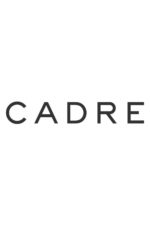Cadre Real Estate Investing
Strengths
- Invest in commercial real estate to supplement your stock and bond portfolio holdings
- ou can invest in either individual properties, or through a managed fund option
- Your investment can be fully or partially to liquidated at regular intervals
- Cadre Real Estate Investing works to make a positive social impact by working with minority partners and in economically depressed regions
Weaknesses
- Accredited investor status required to participate on the platform
Cadre Real Estate Investing invests in commercial real estate, which is a high-risk/reward asset class. Though the returns on commercial real estate can be higher than those on stocks and bonds, those returns will be based on each individual property, and not necessarily the general market.
Because of the high-risk factor, Cadre requires participants to be accredited investors. That means investors who have the financial wherewithal to absorb the potential risks that come with this type of investing.
For accredited investors looking to get into commercial real estate, Cadre is worth checking out. Unlike other commercial real estate investment platforms, Cadre does provide a secondary market. If you choose to liquidate your investment early, you can.
🚨 It appears that Cadre is looking to sell itself to Yieldstreet. As a result, we can no longer recommend them until the sale is either completed or terminated. This is not a knock on Yieldstreet, I think they are a fine company, but we can’t recommend investing with a platform that may be sold due to the uncertainty.
Table of Contents
- What is Cadre Real Estate Investing?
- How Does Cadre Real Estate Investing Work?
- Cadre Real Estate Investing Features
- Cadre Real Estate Investing Plans
- Cadre Real Estate Investing Pricing
- How to Sign Up with Cadre Real Estate Investing
- Who Should Invest with Cadre Real Estate Investing?
- Who Founded Cadre?
- Cadre Real Estate Investing Pros and Cons
- Bottom Line
What is Cadre Real Estate Investing?
Cadre Real Estate Investing was launched in 2014 as a commercial real estate investing platform. Since its founding, the company has closed more than $3 billion in real estate transactions, generating an average of more than 18% in net returns on the four completed property sales it’s had to date. Since its inception, they’ve paid more than $168 million to investors on the platform.
You’ll be given a choice to invest in either individual commercial property deals or a managed fund comprised of a portfolio of properties.
The company has an A+ rating with the Better Business Bureau, their highest rating on a scale of A+ to F.
How Does Cadre Real Estate Investing Work?
Cadre Real Estate Investing uses a fundamental, value-driven approach to investing. They seek to identify commercial real estate deals offering attractive risk-adjusted value. More specifically, they target income-producing properties in major US markets with compelling fundamentals.
Unlike many real estate crowdfunding platforms, Cadre seeks to improve investment value through active management of the properties in their portfolio. This is done through a combination of operational and capital improvements. The company also attempts to maintain a balanced allocation, with 50% invested in multifamily, and the remainder in office, industrial and hotel properties.
This strategy attempts to blend the stability of income generated by multifamily investments, with the greater upside potential of commercial properties.
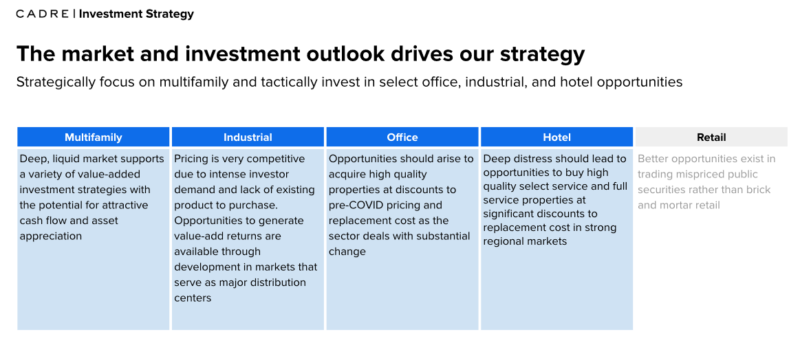
Investment properties include office buildings, multifamily apartment complexes, and retail properties. Because of the nature of the investments offered, investors are advised to expect to hold their positions for at least 10 years to receive the maximum benefit.
The company also seeks geographic diversification, by investing in properties located in the 15 top growth markets across the US. These are primarily Sunbelt cities, such as Dallas, Atlanta, Miami, and Charlotte, in addition to Seattle, Los Angeles, Denver, and Washington DC.
You’ll have a choice to invest with Cadre on either a deal-by-deal basis, investing in individual primary offerings, or through the Cadre Direct Access Fund, which we’ll discuss in detail below.
For individual property investments, snapshot project summaries (“Case Studies”) are presented for each property:
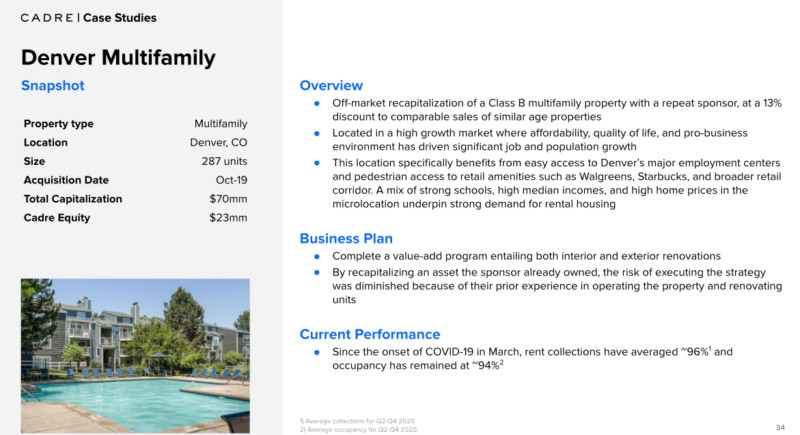
You can also drill down to get deeper and more detailed information about each property offered on the platform.
Learn more about Cadre Real Estate Investing
Cadre Real Estate Investing Performance and Track Record
Specific details of the number, type, and value of investments held by Cadre Real Estate Investing are as follows:
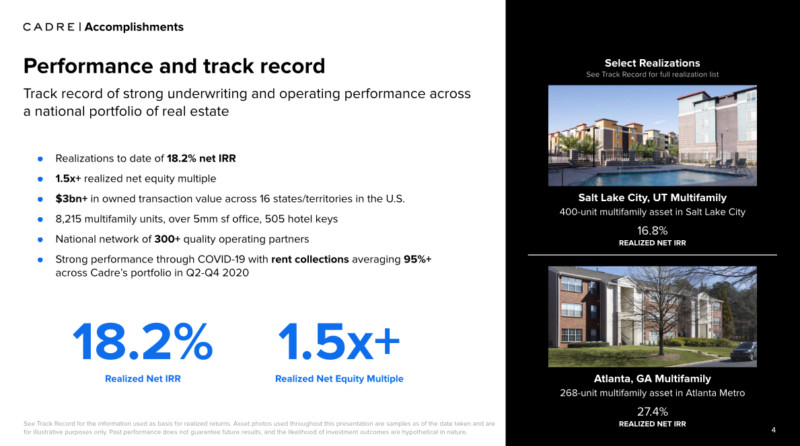
From the screenshot above, you can see that the return on investment thus has far has been 18.2%. This is referred to as the internal rate of return, or IRR. It’s a combination of net rental income received, in addition to proceeds from the sale of appreciated properties. As such, investors won’t realize the full IRR of an investment until after it’s sold.
These returns are not guaranteed, and only represent the returns Cadre Real Estate Investing is providing up to this point.
Cadre Secondary Market
Unlike typical real estate crowdfunding platforms, which require you to maintain your position in an investment until it’s completed, Cadre does provide a secondary market for full or partial liquidation of your position.
After an initial holding period of six months on a new investment, you may be able to sell your position on the platform at a target sale price based on the net asset value of the investment at the time you offer it for sale. However, the company does caution that the ability to sell your position is not guaranteed.
The ability to sell your investments is generally made available on a quarterly basis and within windows established by Cadre. Those windows will typically take place in the middle of each quarter, and last about two weeks.
Cadre will determine the sale price of your investment, which will be determined based on specific discounts to their “Marked Value”. This process seems to hint that while you can dispose of your investment positions, it will very likely be done at less than the actual full value at the time of disposition.
Investment sales require a minimum of $50,000, and may be increased in increments of $5,000. If you have made a partial sale, subsequent sales in the same property must be offered in amounts of at least $10,000.
Proceeds from the sale of your investment positions are expected to be transferred to your bank account within 45 days of completion.
Secondary market fee: There is a fee of 1.5% of the gross transaction price, which is paid by both the buyer and the seller in a secondary market transaction – for a total of a 3% fee.
Cadre Real Estate Investing Features
Minimum investment required: $50,000, which is also the minimum investment per transaction or in the Direct Access Fund.
Allocation and commitment process: Investors can submit a non-binding allocation request to participate in the various investments offered. Allocations are granted after considering account timing, interest level, and overall opportunity size. Once an application is accepted, you’ll receive an online subscription agreement that must be completed prior to funding.
Income distributions: Income is distributed on a quarterly basis, and deposited into your bank account. The amount of the distribution will depend on the performance of each individual investment.
Income tax reporting: Investment results will be reported to both you and the IRS on IRS Form K-1. It will report net rental income, interest income, and other income and expense information, including depreciation.
Customer service: By phone and email, Monday through Friday, from 9:00 AM to 6:00 PM, Eastern time.
Cadre Real Estate Investing Plans
Though you can invest in individual properties on the platform, they do offer a managed investment option, as well as an interest-bearing cash account, which is available to all investors on the platform.
Cadre Direct Access Fund
With a single investment of $50,000, your money will be spread across between 15 and 20 multifamily, industrial, office, and hotel properties located in high potential growth markets across the country.
Similar to individual investments, the fund seeks to generate a combination of annual cash flow with high potential property value growth.
As is the case throughout Cadre’s investment strategy, they use four different investment objectives, each with its own balance of risk and reward. For the Direct Access Fund, they specifically target “Value Add”, which is a medium risk/reward strategy, from which they anticipate an average annual return in the range of 10% to 12%.
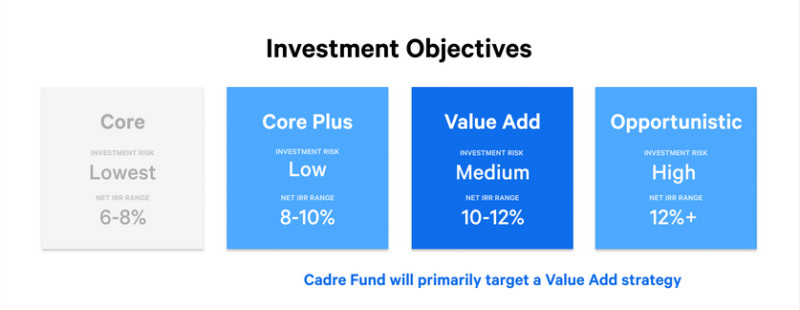
Direct Access Fund Fees: The fee structure for the fund is presented under “Cadre Real Estate Investing Pricing” below.
Cadre Cash
Cadre Cash is an interest-bearing bank account held within the Cadre Real Estate Investing platform. It is automatically available to all investors, and is used to facilitate transfers to and from an external bank account, and to fund investments on the platform. There are no fees associated with this account.
Cash held on the Cadre platform through Cadre Cash is covered by FDIC insurance through the Multi-Bank Program. An account will be opened for you as an investor with Cadre Real Estate Investing. No minimum balance is required for the account.
Money held in the account can be used for regular withdrawals and deposits, just as you would with a personal bank account. However, availability is limited to US individuals and only those with a US-based bank account.
The current yield on the account is 0.001% APY. There are no fees associated with this account, nor are there charges for withdrawals or transfers.
Opportunity Zones
Cadre makes investments available in qualified opportunity zones. Abbreviated “QOZ”, they represent properties located in economically distressed communities where new investments may be eligible for preferential tax treatment.
The IRS defines the tax benefits as follows:
“Investors can defer tax on prior eligible gains to the extent that a corresponding amount is timely invested in a qualified opportunity fund. The deferral lasts until the earlier of the date on which the investment in the (fund) is sold or exchanged, or December 31, 2026. If the investment is held for at least five years, there is a 10% exclusion of the deferred gain. If it’s held for at least seven years, the 10% exclusion becomes 15%… If the investor holds the investment for at least 10 years, the investor is eligible for an adjustment in the basis of investment to its fair market value on the date the investment is sold or exchanged. As a result of this basis adjustment, the appreciation in the fund investment is never taxed.”
These deals do not receive an initial approval by the IRS, but Cadre will file IRS form 8996 each year to report compliance with IRS requirements.
Investors will be able to elect deferral using IRS Forms 8949 and 8897. If you participate in this program, you must consult your tax advisor about specific reporting requirements.
Learn more about Cadre Real Estate Investing
Cadre Real Estate Investing Pricing
Cadre charges two fees for each investment, which is at least partially based on a sliding scale tied to the amount of your investment in an individual property or in the Direct Access Fund.
The first is an annual fee, which is comprised of a management fee and an administration fee. The combination of the two fees will result in an annual charge of 2% of your investment under $1 million, or 1.75% on investments over $1 million.
There is also a one-time commitment fee, also based on the amount of your investment, that ranges between 1% and 3.5% of your investment.
The fee schedule is as follows:
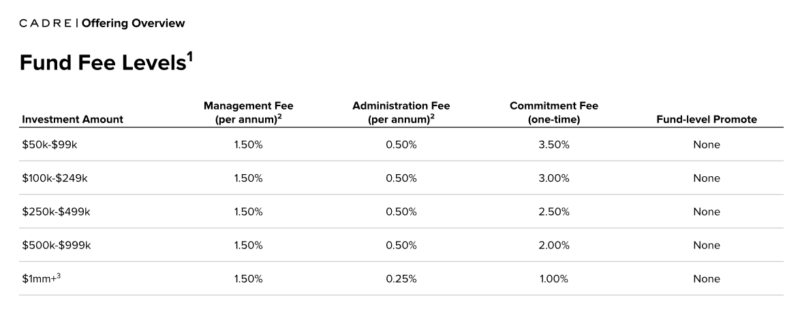
How to Sign Up with Cadre Real Estate Investing
To be eligible to invest with Cadre Real Estate Investing, you must be an accredited investor. That means you must have had an annual income of at least $200,000 per year if you are single, or $300,000 if you are married. Alternatively, you can qualify if you have a minimum net worth of $1 million, not including your primary residence.
You can sign up for the service directly from the website by clicking the “Get Started” button.
You’ll then be asked to indicate if you are an individual investor or a financial advisor.
Next, you’ll be required to confirm your status as an accredited investor, then provide your name, phone number, and country of residence. You’ll then provide your email address and set up a unique password, and you’ll be in.
From there, you’ll be asked a series of questions to determine your investment goals, previous real estate investing experience, risk tolerance, and time horizon.
Finally, you’ll be asked to indicate your approximate net worth (but you have the option to not disclose this information). Once you’ve completed each of these steps, you’ll have access to the investment platform.
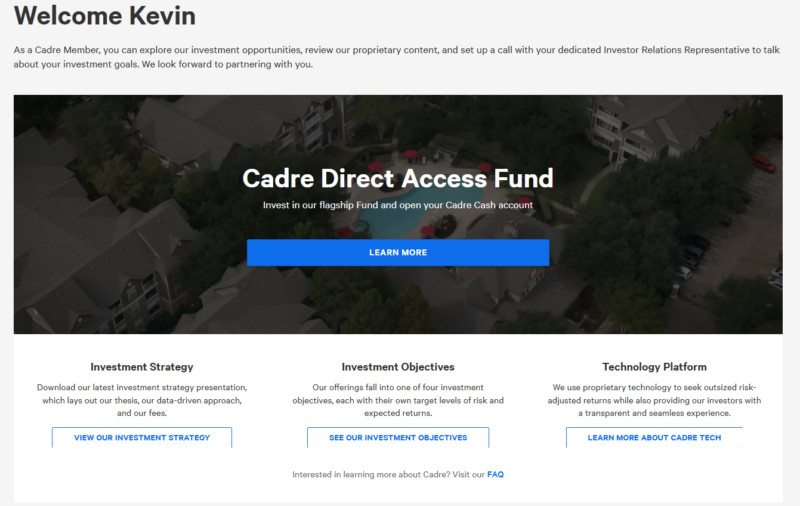
Once you have access to the platform, you’ll receive an email from the company, and you can schedule an introductory phone call if you choose.
For funding purposes, you’ll need to link a US-based bank to your Cadre account. Cadre cannot accommodate non-US individuals or non-US banks at this time.
Additional Verification Requirements
Since you’ll be opening a bank account through Cadre Cash, you will be required to verify your identity. To do so, you’ll need to upload your driver’s license or passport, and may be required to provide your Social Security card as well.
You should also be aware that Cadre is required to verify your status as an accredited investor. You’ll need to upload documentation that will prove you qualify for this status. Those can include W-2s, complete tax returns, a letter from a broker-dealer, SEC registered investment advisor, licensed attorney, or CPA, stating that you are an accredited investor (also known as a verification letter), or through Individual BrokerCheck reports.
If you aren’t an accredited investor but still want to get into real estate there are options. Here’s our list of the best real estate crowdfunding sites — many of which do not require accreditation.
Who Should Invest with Cadre Real Estate Investing?
Cadre Real Estate Investing can be an excellent choice for accredited investors who are looking to diversify their portfolios away from stocks and bonds, and into commercial real estate.
It’s a high-risk/high reward opportunity, but it’s a way of diversifying into an asset class that’s not directly correlated with the financial markets. It also offers an opportunity to earn portfolio income from real estate and other financial assets.
Cadre Real Estate Investing is not suitable for investors who are not accredited, or for those who are and don’t understand the risks associated with commercial real estate.
Who Founded Cadre?
Cadre Real Estate Investing was founded by Ryan Williams who is also its chief executive officer. Prior to the founding of Cadre, Williams was involved in over $3 billion in transactions in the real estate private equity division of The Blackstone Group.
Before working at Blackstone, he worked in the technology media group of Goldman Sachs, working on transactions totaling more than $5 billion.
Learn more about Cadre Real Estate Investing
Cadre Real Estate Investing Pros and Cons
Pros:
- Invest in commercial real estate to supplement your stock and bond portfolio holdings.
- You can invest in either individual properties, or through a managed fund option.
- Your investment can be fully or partially to liquidated at regular intervals, a benefit that isn’t offered by most real estate crowdfunding platforms.
- Cadre Real Estate Investing works to make a positive social impact by working with minority partners and in economically depressed regions.
Cons:
- Accredited investor status required to participate on the platform.
- High minimum investment at $50,000.
- Limited number of investment opportunities available.
Bottom Line
If you qualify as an accredited investor, and you’re looking to diversify away from a portfolio comprised entirely of stocks and bonds, commercial real estate can help you accomplish that goal.
Cadre Real Estate Investing will give you an opportunity to either invest in individual property deals or through their Direct Access Fund. If you prefer a managed portfolio option.
